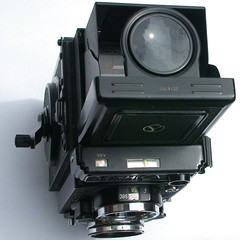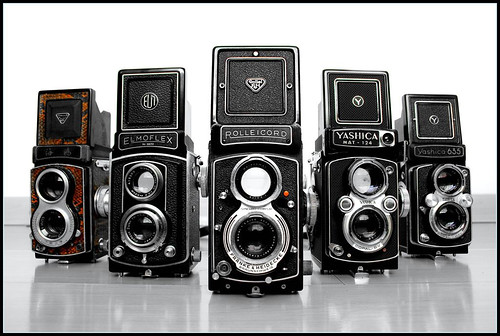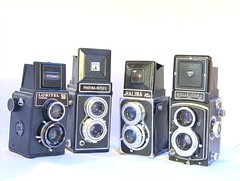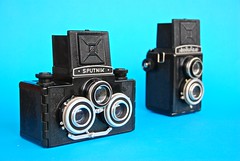TLR
For a list of TLR cameras, see TLR category.

|
| details: film advance knurl and ground glass loupe (Image rights) |
TLR stands for Twin Lens Reflex. The camera uses two lenses of equal focal length, one for viewing and focusing and the other for taking the photograph; reflex refers to the mirror used behind the viewing lens that makes focusing possible.

|
| the typical TLR: for 6×6cm frame size, image by Elmo Alves (Image rights) |

|
| 6×6cm TLRs, image by wedste (Image rights) |
Twin Lens Reflex (TLR) cameras are "two-eyed" cameras such as any model of Rolleiflex. They normally consist of two lenses of equal focal length and equal "speed". They are mounted in the front of the case, and their focusing is synchronized so that they are always focused at the same distance. The difference is that the upper lens projects the incoming image via mirror up to the reflex finder's ground glass whilst the lower one (the "taking" lens) projects the image into the camera's dark chamber and onto the film plane. The taking lens can be stopped down whilst the finder lens is always at maximum aperture.
The scene viewed by the top lens is reflected by a mirror onto the ground glass screen so that the image seen there is laterally inverted (left is right, right is left), which can take some time to get used to.
The taking lens exposes the film. The distance between the centre of the viewing lens and that of the taking lens is known as parallax error; if the subject of the photographs permit, this can be corrected by lifting the camera until the taking lens is as high as the viewing lens was when the image was composed.
Well-known TLR manufacturers are the German Rollei, the Japanese Yashica, and the Chinese Seagull. A variety of TLRs were also made by a great number of Japanese companies, particularly in the 1950s; innovative designs from diminishing number (particularly Mamiya) continued much longer. "Lomagraphists" prefer old Soviet LOMO TLRs.
The vast majority of TLRs take 120 film and expose 12 pictures in 6×6cm format. Some models did take 127 film and expose 12 pictures in 4×4 format, and there are a few models using other formats (e.g. the Superfekta and Ontoflex took 6x9cm images; the Agfa Flexilette and Contaflex TLR used 35mm film).
Not every camera that outwardly resembles a TLR actually is one; see pseudo-TLR.

|
| stereo camera Sputnik based on TLR technology image by Dirk HR Spennemann (Image rights) |
Pros
- TLRs are typically very quiet, as the leaf shutter is quiet and no mirror moves.
- The viewfinder image matches the image size on film.
- There is no viewfinder blackout during exposure.
- TLRs use leaf shutters, which can sync with a flash at any speed.
- Used conventionally, TLRs are "waist-level" cameras. (In reality, they are more often chest-level.) Numerous photographers claim that subjects are usually more relaxed and less likely to strike poses for photographers using waist-level cameras.
- When necessary, conventional TLRSs can be lifted above the head and the finder viewed from below.
Cons
- Parallax is a problem at close distances.
- Reversed image (image is upright but reversed left to right).
- Unlike an SLR, no impression of depth-of-field can be given in the viewfinder, as the viewing lens has no diaphragm.
- Most don't have interchangeable lenses (exceptions: Mamiya C series and Koni-Omegaflex).
- Can be relatively large and heavy (depending on brand and model).
Links
In English:
- TLR shutter repair at Rick Oleson's website
- Medium Format on a Budget: TLR at TheBokeh.com
- TLR page at the Medium Format Photography Megasite
- Points to watch when buying a TLR, in a page at Rolleigraphy
- Barry Toogood's good site on TLR: www.tlr-cameras.com
In Japanese:
In French: